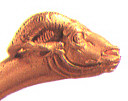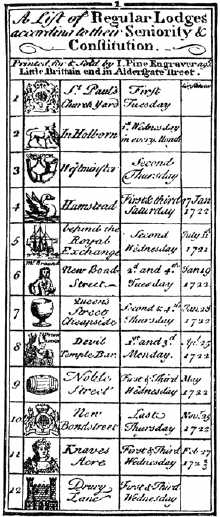
site map
Golden Fleece > Goose and Gridiron
craftsman's art and music's measure
for thy pleasure all combine.
Goose and Gridiron
St John's Day 1717

Four lodges, which had been associated with re-building of St. Paul’s Cathedral, under the direction of Sir Christopher Wren met at the Goose and Gridiron Ale House, St Paul’s Churchyard, London in June 1717. They resolved to revive an Annual Festival to perform the ‘Antient Drama’ commemorating the slaying of Hiram Abif. This ‘Antient Drama’ was subsequestly adapted to create the third degree. The Annual Festival evolved into a regulatory body, which met in Quarterly Communications and attracted lodges meeting outside London. The orginal four lodges were named for the place where they met:
- Goose and Gridiron Ale-house in St. Paul's Church-yard;
- Crown Ale-house in Parker's Lane near Drury's Lane;
- Apple Tree Tavern in Charles Street, Covent Garden;
- Rummer and Grapes Tavern in Channel Row, Westminster.

Engraved Lists
According to the engraved list of 1729, the lodge which met at the Goose and Gridiron was constituted in 1691.
A lodge meeting at the Golden Fleece tavern at Bury St. Edmunds was number 81 in the Engraved List of Regular Lodges for 1734.
From 1725 to 1741, annual engraved lists of Lodges were produced by John Pine. Each Lodge was distinguished by a miniature engraving of a sign appropriate to the Lodge, usually that of the tavern where the Lodge met, and details of the time and place of meeting.

Pine was a member of the prestigious Lodge which met at the Horn Tavern in Westminster, one of the four Lodges which formed the Grand Lodge in 1717. The frontispiece of James Anderson’s 1723 Constitutions of the Free-Masons was engraved by Pine. This frontispiece shows John, 2nd Duke of Montagu, Grand Master from 1721-1722 handing the Constitutions to his successor, Phillip, Duke of Wharton, Grand Master 1722-1723. Beneath the figures is the 47th Proposition of Euclid. A classical setting presents each of the orders of architecture and the Sun God Apollo in his fiery chariot. Underneath are the words ‘Engraved by John Pine in Aldersgate Street London’.
Apprenticed to a London goldsmith at the age of 19, Pine became a freeman of the city in 1718 and set himself up as an engraver in Fleet Street. He had a sensational success with a vivid portrait of the castaway in his goatskin clothes as the frontispiece for Daniel Defoe’s Robinson Crusoe. The success of Crusoe enabled him to establish a thriving business near Aldersgate.
Duke of Montagu
In 1721, John, Duke of Montagu was elected Grand Master. John, 2nd Duke of Montagu, was invested as a Knight of the Order of the Garter in 1719 and was a fellow of the Royal Society. He was married to Lady Mary Churchill, daughter of John Churchill, 1st Duke of Marlborough.
Duke of Richmond
Charles, Duke of Richmond was elected Grand Master in 1724, was invested as a Knight of the Order of the Garter in 1726 and was a fellow of the Royal Society.
Freemasonry in the News
This news from London was reported in the Leeds Mercury April 7 to 14, 1730:
A few days since, their Graces the Dukes of Richmond and Montague, accompanied by several Gentlemen, who were all Free and Accepted Masons, according to Antien Custom, formed a Lodge upon the Top of a Hill near the Duke of Richmond’s Seat, at Goodwood in Sussex, and made the Right Hon. the Lord Baltimore a Free and Accepted Mason.
Grand lodges were established in Scotland and Ireland. For the first time since the days of William Schaw existing lodges began to receive central guidance and direction.
At the time of Sir Christopher Wren, a lodge was formed by five masons: Tyler, Junior and Senior Wardens, Master of the lodge and the newest freemason. Tyler was an ancient office, responsible for delivering summons to lodge meetings and acting as doorkeeper, which was particularly important for any Lodges meeting in a tavern. The Tyler also had a traditional role of representing poor and distressed freemasons.

The newest freemason had an important role in the admisison of the next apprentice. First he would admit the candidate on the point of the trowel. In the north east part of the lodge, he would present the flat surface of the trowel to the candidate to receive any contributions for poor and distressed freemasons. Finally he would pass the trowel to the new apprentice. This is the origin of the expression, "that Monarchs themselves have not thought it derogatory to their dignity to exchange the sceptre for the trowel."
The making of accepted masons was originally conducted on a single day in two parts; apprentice and fellow. The ‘Antient Drama’ commemorating the slaying of Hiram Abif was performed at Annual Festivals of several lodges meeting on St John's Day. Eventually this material was reorganised and extended to create three symbolic degrees, although with minor variations in different states and countries.
Copyright © 2001-2009 The Fleece. All rights reserved.